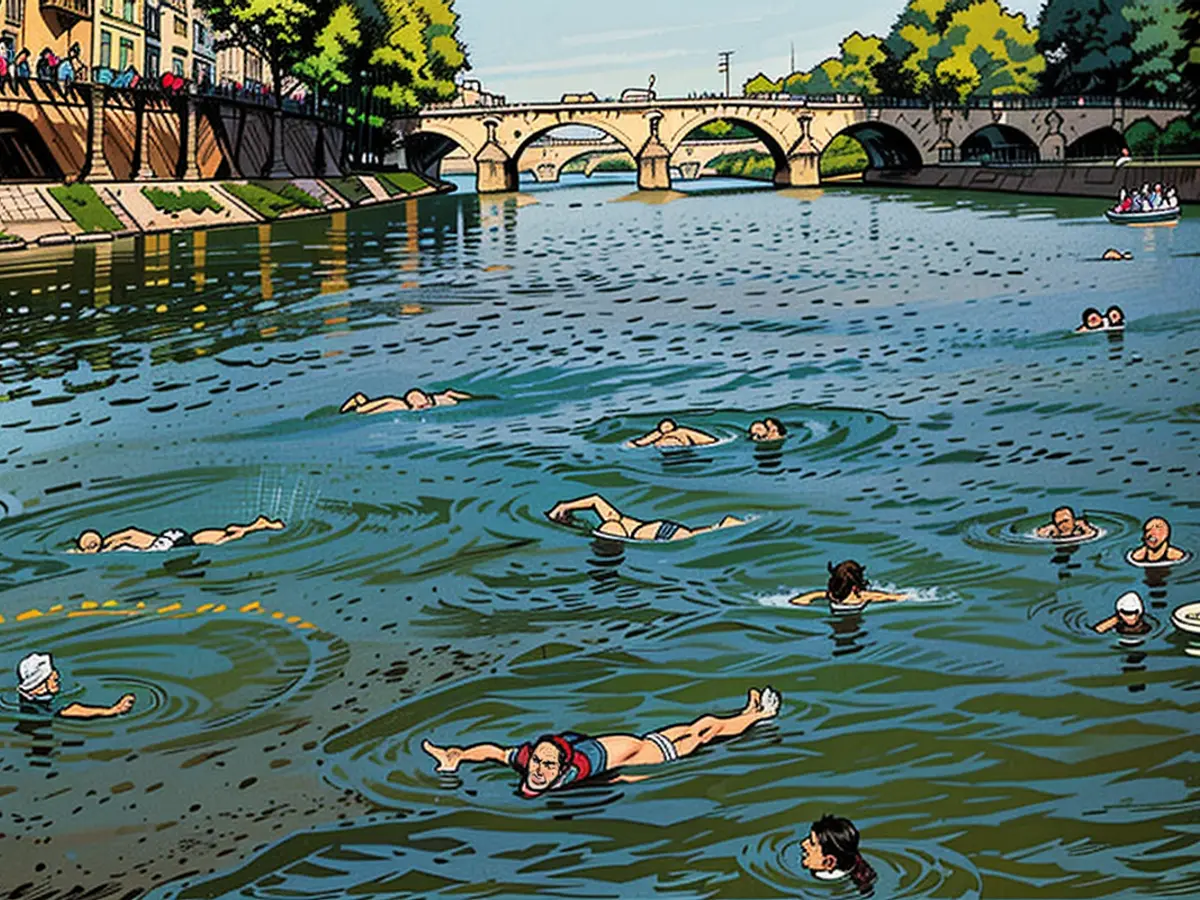Olympia 2024 Versailles-Paris France - Comment nettoyer réellement une rivière ?
With the commitment "Épargner la Seine", Anne Hidalgo, mayor of Paris, secured the Olympics bid seven years ago and pledged to the citizens of her city that they would clean the Seine so effectively that swimming disciplines could take place in it. Since then, the city of Paris has invested over 1.4 billion Euros into this project.
But how does one clean up such a large river? Why was the Seine so polluted in the first place? And can a cleaner river enhance the quality of life in a city?
The Water Pollution Issue in the Parisian Seine
The canal system connected directly to the Seine is almost 250 years old. At that time, there were around one million people living in the city. Today, the city has over eleven times as many inhabitants. Due to above-average and rapid population growth, many households could not be connected to the canal system – a situation that still exists today. Additionally, the old canal system was not designed for today's common extreme weather conditions, adding to the city's challenges.
"During strong storms, the entire water was always directed into the river," explains Emmanuel Olivard, Chief Canal Worker in Paris, to ARD. Household and industrial wastewater, as well as rainwater, were all directed over the same canal system. The result: During heavy rainfall, the underground system was quickly overwhelmed, causing the canals to overflow. Unfiltered wastewater, including feces, chemicals, and other pollutants, flowed into the Seine. Contaminated water poses a risk for swimmers, as they can contract gastrointestinal, skin, or respiratory infections.
The 1.4 Billion Euro Project: How the Seine is being cleaned
Since the free swimming competitions of the Olympics are to take place in the Seine, the city now had to take measures to clean the river. For instance, it operates several clarification plants. The water is cleaned in several steps: Coarse solids are removed, sand and silt settle, microorganisms break down pollutants, and finally, the water is disinfected to kill bacteria.
Through new constructions and renovation projects, a modern canal system was installed, which separates rain and household water to reduce the load on the clarification plants. The connection of households and boats to the sewage system was especially important, as it significantly reduces direct wastewater discharge into the Seine. The city financially supported homeowners to lower the costs of connecting to the sewage system.
The project is groundbreaking, but even though Paris has already invested 1.4 billion Euros in the Seine's cleanup, the Olympics' water quality standards are not yet guaranteed. If it rains heavily, and too much wastewater enters the Seine, the Olympic water quality standards might not be met. For example, the triathlon would not be possible, and athletes would have to settle for a "duathlon" instead, according to Parisian authorities.
The problem of pollution is not limited to France. According to the environmental agency, only eight percent of German rivers are in a good or very good ecological condition. One of these supposedly clean rivers is the Isar, which also flows through a metropolis. In Munich, people can swim carelessly in the Isar. In summer, it is one of the most important meeting points for Munich residents: they meet there, go swimming or surfing or let themselves be carried away by the gentle current. However, the Isar faces the same problem as the Seine. It must be permanently cleaned in order for swimmers to be able to swim in it safely.
Hartmut Keitel is the founder of the association "Ta Isar" and has been taking care of its maintenance for years. On his website, he writes that the Isar is now cleaner thanks to modern clarification techniques and usually has good water quality. He explains a similar clarification method, which is now also used at the Seine. He says: "The sewage goes through systems that inactivate colibacteria with UV light. This prevents illnesses from waterborne diseases if the water is accidentally swallowed."
Similar to the Seine in Paris, there is a fundamental problem in Munich: maintaining the cleanliness of the Isar during heavy rainfalls. Hartmut Keitel explains: "The clarification plants upstream have limited capacity." When too much water enters the sewage systems due to heavy rainfalls, the excess water must be diverted to the clarification and cleaning systems. The water cannot be filtered and purified properly, and according to Keitel, this can lead to a disruption of water quality.
Another example of the positive cleaning of a river is the Rhine. In the 1950s, the Rhine was considered one of the "great sewers of Europe." All authorities and industries tried various measures to improve water quality. With success. Nowadays, hardly any untreated sewage enters the Rhine. A series of monitoring stations constantly check the water quality.
In Basel, people especially enjoy the clean Rhine. Equipped with a waterproof bag (a waterproof sack), businessmen and women, among others, clean themselves out of their suits in the Rhine, store their expensive outfits in the bags, and let themselves be carried away by the current, enjoying the panorama, and get out of the river when they have reached their goal. They swim to work.
In Munich and Basel, it has been achieved to integrate the city's rivers into daily life. The cleaning measures have long-term effects. Whether the Seine will be maintained beyond the Olympics is still open. If the measures were to take effect in Paris, the Seine could also establish itself as a swimmable river.
- Pour assurer encore la qualité de l'eau de la Seine, la ville de Paris considère l'installation de plus de stations de clarification telles que celles déjà en fonctionnement.
- Le nettoyage de l'Isar, un fleuve de Munich, a considérablement progressé ces dernières années grâce à l'utilisation de techniques de clarification modernes, similaires à celles utilisées dans la Seine.
- Malgré les efforts continuels pour nettoyer la Seine, les normes de qualité d'eau des Jeux olympiques peuvent ne pas être atteintes pendant des pluies intenses, entraînant des modifications possibles dans des événements sportifs comme le triathlon.
- Hartmut Keitel, le fondateur de "Deine Isar," met en évidence l'importance de maintenir la propreté de l'Isar même pendant des pluies intenses, car l'excès d'eau peut compromettre les systèmes de clarification et de nettoyage.
- Le Rhin, autrefois considéré l'un des "grands canaux" d'Europe, a connu une amélioration spectaculaire en matière de qualité de l'eau grâce aux mesures prises par les autorités et les industries pendant des décennies.
- À Munich, la ville olympique, l'Isar est largement utilisée pour des activités récréatives telles que la natation et le surf, mettant en valeur le potentiel de fleuves rénovés pour améliorer la vie dans la ville.
- Le plan ambitieux d'Anne Hidalgo de transformer la Seine en une rivière nageable pour les Jeux olympiques parisiens a mis le problème du nettoyage des rivières au premier plan, inspirant de similaires initiatives à travers le monde.
- Les rubriques de nouvelles du Top-News ont documenté les progrès faits dans le nettoyage de la Seine et d'autres rivières, reflétant l'intérêt mondial pour la conservation des ressources d'eau fraîche et la promotion de la croissance urbaine durable.
- Munich et Basel sur le Rhin ont réussi à intégrer leurs rivières dans la vie quotidienne de la ville, démontrant que des initiatives de nettoyage peuvent contribuer à une augmentation de la vivabilité et de l'engagement communautaire.
- La ville d'Olympia, berceau des Jeux olympiques grecs antiques, pourrait également bénéficier d'investissements dans ses projets de nettoyage des voies d'eau, apportant une nouvelle appreciation au site historique tout en promouvant une relation plus durable avec ses ressources naturelles.

Lire aussi:
- Des vendeurs de café aux stars de la publicité : les entraîneurs des Championnats d'Europe
- L'annonce de Nagelsmann : un Noël agité pour les joueurs de l'équipe nationale
- Le calme avant le changement : les plans de Nagelsmann pour l'Euro
- Un conte de fées pour l'Autriche ? "La course à pied, c'est possible








